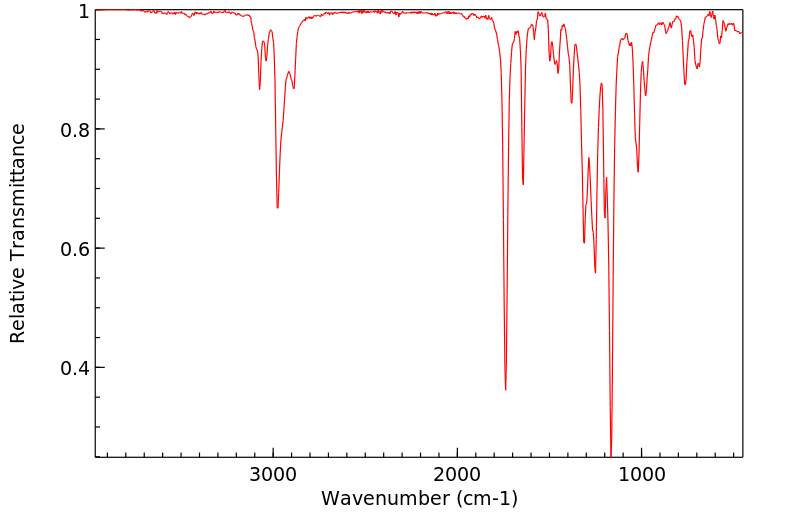isobutyl cinnamate | 31416-74-7
中文名称
——
中文别名
——
英文名称
isobutyl cinnamate
英文别名
(E)-isobutyl cinnamate;2-methylpropyl (E)-3-phenylprop-2-enoate
CAS
31416-74-7
化学式
C13H16O2
mdl
——
分子量
204.269
InChiKey
IQZUZPKOFSOVET-CMDGGOBGSA-N
BEILSTEIN
——
EINECS
——
-
物化性质
-
计算性质
-
ADMET
-
安全信息
-
SDS
-
制备方法与用途
-
上下游信息
-
文献信息
-
表征谱图
-
同类化合物
-
相关功能分类
-
相关结构分类
物化性质
-
LogP:3.830 (est)
-
物理描述:Colourless liquid, sweet fruity balsamic odour
-
溶解度:insoluble in water; soluble in oils
-
密度:1.001-1.005
-
折光率:1.538-1.542
-
保留指数:1598;1619;1601;1604.6;1598
计算性质
-
辛醇/水分配系数(LogP):4
-
重原子数:15
-
可旋转键数:5
-
环数:1.0
-
sp3杂化的碳原子比例:0.31
-
拓扑面积:26.3
-
氢给体数:0
-
氢受体数:2
上下游信息
-
上游原料
中文名称 英文名称 CAS号 化学式 分子量 反式-桂皮酸酐 cinnamic anhydride 21947-71-7 C18H14O3 278.307 肉桂酸 (E)-3-phenylacrylic acid 140-10-3 C9H8O2 148.161 -
下游产品
中文名称 英文名称 CAS号 化学式 分子量 3-苯基丙-2-烯-1-醇 (2E)-3-phenyl-2-propen-1-ol 4407-36-7 C9H10O 134.178
反应信息
-
作为反应物:描述:isobutyl cinnamate 在 [Ru(2-(methylthio)-N-[(pyridin-2-yl)methyl]ethan-1-amine)(triphenylphosphine)Cl2] 、 potassium tert-butylate 、 氢气 作用下, 以 十二烷 、 甲苯 为溶剂, 40.0 ℃ 、3.0 MPa 条件下, 反应 4.0h, 以95%的产率得到3-苯基丙-2-烯-1-醇参考文献:名称:[EN] SELECTIVE REDUCTION OF ESTERS TO ALCOHOLS
[FR] RÉDUCTION SÉLECTIVE D'ESTERS EN ALCOOLS摘要:这项发明涉及酯的选择性还原为它们对应的醇。公开号:WO2017194663A1 -
作为产物:描述:参考文献:名称:肉桂酸衍生物及其杂芳环类似物作为潜在的高效杀青霉菌的生物活性和结构-活性关系摘要:合成了一系列肉桂酸衍生物及其杂芳族环类似物,并评价了其对against螨(Psoroptes cuniculi)的体外杀螨活性。其中,有8种化合物显示出更高的活性,中位致死浓度(LC 50)为0.36–1.07 mM(60.4–192.1 µg / mL),并且具有开发新型杀螨剂的巨大潜力。化合物40的最低LC 50值为0.36 mM(60.4 µg / mL),最小中值致死时间(LT 50)在4.5 mM时为2.6 h,与伊维菌素相当[LC 50 = 0.28 mM(247.4 µg / mL) ,LT 50 = 8.9 h],这是一种杀螨药物标准。SAR分析表明,羰基对活性至关重要。酯部分中烷氧基的类型和链长以及酯基附近的空间位阻显着影响活性。该酯比相应的硫羟酸酯,酰胺,酮或酸更具活性。用α-吡啶基或α-呋喃基取代肉桂酸酯的苯基会显着提高活性。因此,出现了一系列具有优异杀螨活性的肉桂酸酯及其杂芳族环类似物。DOI:10.1016/j.bmcl.2017.08.051
文献信息
-
Ruthenium-Catalyzed Oxidative Cross-Coupling Reaction of Activated Olefins with Vinyl Boronates for the Synthesis of (<i>E</i>,<i>E</i>)-1,3-Dienes作者:Dattatraya H. Dethe、Nagabhushana C. Beeralingappa、Amar UikeDOI:10.1021/acs.joc.0c02823日期:2021.2.19An oxidative cross-coupling reaction between activated olefins and vinyl boronate derivatives has been developed for the highly stereoselective construction of synthetically useful (E,E)-1,3-dienes. The highlight of this reaction is that exclusive stereoselectivity (only E,E-isomer) was achieved from a base-free, ligand-free, and mild catalytic condition with a less expensive [RuCl2(p-cymene)]2 catalyst
-
Inexpensive Ruthenium NNS-Complexes as Efficient Ester Hydrogenation Catalysts with High C=O vs. C=C Selectivities作者:Bernhard M. Stadler、Pim Puylaert、Justus Diekamp、Richard van Heck、Yuting Fan、Anke Spannenberg、Sandra Hinze、Johannes G. de VriesDOI:10.1002/adsc.201701607日期:2018.3.20Ru(NNS)(PPh3)Cl2 (NNS=2‐(methylthio)‐N‐(pyridin‐2‐yl‐methyl)ethan‐1‐amine) was employed in the hydrogenation of α,β‐unsaturated esters, reaching selectivities for the allylic alcohol up to 95% in the hydrogenation of iso‐butylcinnamate. In addition, several ester substrates were hydrogenated with catalyst loadings as low as 0.05 mol%. Surprisingly, selectivity of the hydrogenation of the C=O vs the
-
BITTER TASTE MODIFIERS INCLUDING SUBSTITUTED 1-BENZYL-3-(1-(ISOXAZOL-4-YLMETHYL)-1H-PYRAZOL-4-YL)IMIDAZOLIDINE-2,4-DIONES AND COMPOSITIONS THEREOF申请人:SENOMYX, INC.公开号:US20160376263A1公开(公告)日:2016-12-29The present invention includes compounds and compositions known to modify the perception of bitter taste, and combinations of said compositions and compounds with additional compositions, compounds, and products. Exemplary compositions comprise one or more of the following: cooling agents; inactive drug ingredients; active pharmaceutical ingredients; food additives or foodstuffs; flavorants, or flavor enhancers; food or beverage products; bitter compounds; sweeteners; bitterants; sour flavorants; salty flavorants; umami flavorants; plant or animal products; compounds known to be used in pet care products; compounds known to be used in personal care products; compounds known to be used in home products; pharmaceutical preparations; topical preparations; cannabis-derived or cannabis-related products; compounds known to be used in oral care products; beverages; scents, perfumes, or odorants; compounds known to be used in consumer products; silicone compounds; abrasives; surfactants; warming agents; smoking articles; fats, oils, or emulsions; and/or probiotic bacteria or supplements.本发明涵盖已知用于改变苦味感知的化合物和组合物,以及所述组合物和化合物与额外的组合物、化合物和产品的组合。示例组合物包括以下一种或多种:冷却剂;无活性药物成分;活性药用成分;食品添加剂或食品;调味剂或调味增强剂;食品或饮料产品;苦味化合物;甜味剂;苦味剂;酸味调味剂;咸味调味剂;鲜味调味剂;植物或动物产品;已知用于宠物护理产品中的化合物;已知用于个人护理产品中的化合物;已知用于家用产品中的化合物;制药制剂;局部制剂;大麻衍生或与大麻相关的产品;已知用于口腔护理产品中的化合物;饮料;香味、香水或除臭剂;已知用于消费品中的化合物;硅化合物;磨料;表面活性剂;发热剂;吸烟物品;脂肪、油脂或乳化剂;和/或益生菌或补充剂。
-
Palladium(II)-catalyzed catalytic aminocarbonylation and alkoxycarbonylation of terminal alkynes: regioselectivity controlled by the nucleophiles作者:Rami Suleiman、Jimoh Tijani、Bassam El AliDOI:10.1002/aoc.1585日期:——the selectivity towards the gem or trans unsaturated esters or amides with these nucleophiles. The effects of the type of palladium catalysts, the type of ligands, the amount of dppb and the solvents were carefully studied. With diisobutylamine (2b1), excellent regioselectivity towards the 2‐acrylamides (gem isomer, 3ab1) was almost always observed, while trans‐α,β‐unsaturated esters 4ac1 was the predominant末端炔烃氨基羰基和烷氧羰基的反应发生平稳且高效地使用的催化剂体系的Pd(OAC)2 -dppb- p -TsOH CH 3 CN CO相对温和的实验条件下。使用两种不同的亲核试剂(醇和胺)对催化体系进行了测试和优化。苯乙炔(1a)被认为是炔烃,而二异丁胺(2b 1)和甲醇(2c 1)被认为是亲核试剂。结果显示1a的转化率和对宝石或反式的选择性的显着差异这些亲核试剂的不饱和酯或酰胺。仔细研究了钯催化剂类型,配体类型,dppb量和溶剂的影响。使用二异丁胺(2b 1),几乎总是观察到对2-丙烯酰胺(宝石异构体3ab 1)具有极好的区域选择性,而反式α,β-不饱和酯4ac 1是以甲醇(2c 1)为亲核试剂的主要产物。。这种对反应选择性的显着敏感性表明了这些羰基化反应的两种不同的可能机理。版权所有©2009 John Wiley&Sons,Ltd.
-
Kinetics of trans-Cinnamic Anhydride Reactions Catalyzed by Pyridine, 4-Dimethylaminopyridine, and N-Methylimidazole作者:Shu-Fen Lin、Kenneth A. ConnorsxDOI:10.1002/jps.2600700302日期:1981.3pyridine, 4-dimethylaminopyridine, and N-methylimidazole as catalysts. The absolute rates of the catalyzed hydrolysis decreased with increasing acetonitrile content (decreasing solvent polarity), but the catalytic efficiency of N-methylimidazole and 4-dimethylaminopyridine relative to pyridine increased as the solvent polarity decreased. The relative catalytic rates for the cinnamoylation of n-propanol
表征谱图
-
氢谱1HNMR
-
质谱MS
-
碳谱13CNMR
-
红外IR
-
拉曼Raman
-
峰位数据
-
峰位匹配
-
表征信息
同类化合物
(E)-3-(4-(叔丁基)苯基)丙烯酸乙酯
(E)-3-(2-(三氟甲基)苯基)丙烯酸乙酯
(E)-3-(2,4-二甲氧基苯基)丙烯酸乙酯
(2E)-N-[2-(3-羟基-2-氧代-2,3-二氢-1H-吲哚-3-基)乙基]-3-苯基丙-2-烯酰胺
黄金树苷
鲁索曲波帕
香豆酸肉桂酯
香豆酰多巴胺
香草醛缩丙酮
顺式邻羟基肉桂酸
顺式芥子酸
顺式-曲尼司特
顺式-乙基肉桂酸酯
顺式-N-阿魏酰酪胺
顺式-3,4-二甲氧基苯丙烯酸
顺式-2-((叔丁氧羰基)氨基)-3-(4-氨甲酰基-2,6-二甲苯基)丙烯酸甲酯
顺-o-羧基肉桂酸
顺-2-甲氧基肉桂酸
阿魏酸钠
阿魏酸酰胺
阿魏酸甲酯
阿魏酸甲酯
阿魏酸甲酯
阿魏酸松柏酯
阿魏酸杂质1
阿魏酸异辛酯
阿魏酸哌嗪
阿魏酸二十烷基酯
阿魏酸乙酯
阿魏酸4-O-硫酸二钠盐
阿魏酸-D3
阿魏酸
阿魏酸
阿魏酰酪胺
间羟基肉桂酸
间羟基肉桂酸
间硝基肉桂酸
间甲基肉桂酸
间甲基反式肉桂酸甲酯
间氯肉桂酸
间三氟甲氧基肉桂酸甲酯
间-香豆酸
间-(三氟甲基)-肉桂酸
锂(E)-2-溴-3-苯基丙烯酸酯
钠二乙基2-[(氧代氨基)-苯基亚甲基]丙二酸酯盐
酪氨酸磷酸化抑制剂AG 556
酪氨酸磷酸化抑制剂AG 527
酪氨酸磷酸化抑制剂AG 490
酪氨酸磷酸化抑制剂A46
酪氨酸磷酸化抑制剂 AG 30








